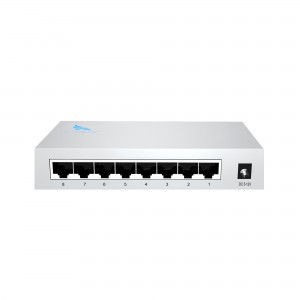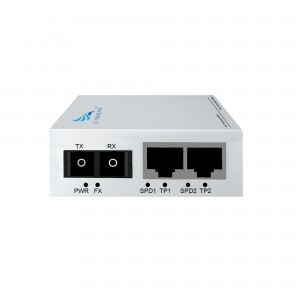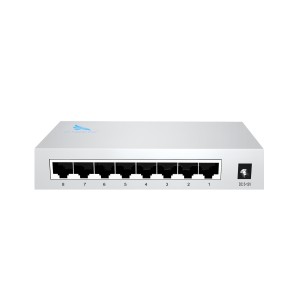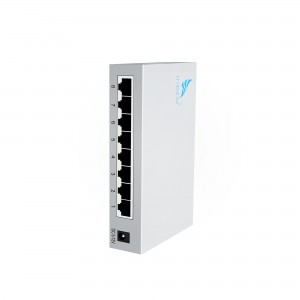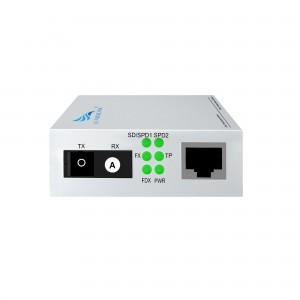5-port 10/100M WDM Media Converter (Single-mode Single-fiber SC)
5-port 10/100M WDM Media Converter (Single-mode Single-fiber SC)
Product Features:
SC fiber optic transceiver introduction:
YOFC is proud to launch SC fiber optic transceiver, which is a cutting-edge optical-to-electrical converter specially designed to meet your communication needs. With our state-of-the-art technology and commitment to innovation, we have developed a product that combines efficiency, reliability and versatility, making it the ideal solution for any communications setup.
At YOFC, we strive to provide excellent quality and performance, which is why our SC fiber optic transceivers have a series of advanced functions. The transceiver features a 1 optical to 4 electrical single-mode single-fiber A-end configuration for seamless data transmission over long distances. With this great feature, you can easily connect multiple devices to ensure efficient communication across your network.
In addition to unrivaled performance, our SC fiber optic transceivers offer many other attractive features. Its low power consumption ensures energy efficiency, reduces operating costs and promotes sustainability. Dynamic LED indicators provide clear, real-time status updates for quick and easy monitoring and troubleshooting. Plus, the 4-digit dial ensures easy, hassle-free configuration, ensuring optimal settings every time.
As a leading manufacturer in the industry, YOFC is proud of its commitment to customer satisfaction. We understand that every business has unique communication needs, and we work hard to meet those needs. With over 20,000 square meters of production space and a dedicated team of over 30 R&D professionals, we have the ability to customize our products to your exact specifications.
In addition to our product customization services, we also offer comprehensive solutions tailored to your specific needs. Our team of experts will work closely with you to develop the perfect communication setup, ensuring seamless integration and maximum efficiency. In addition, we produce 5,000 switches per day, ensuring timely delivery to meet your order requirements without compromising quality.
With YOFC’s SC fiber optic transceivers, you can elevate your communication infrastructure to a new level. Trust our expertise and experience to provide you with superior products that deliver unrivaled performance, reliability and efficiency. Contact us today to find out how our innovative solutions can revolutionize your communications network.
What This Product Does
◇ CF-1014SW-20A is a Hundred megabytes media converter, providing a Hundred megabytesRJ-45 port and a Hundred megabytes SC fiber port, which can convert between electrical and optical signals.
How This Product Works
◇ CF-1014SW-20A adopts WDM (wavelength division multiplexing) technology, helping send and receive data at a distance of up to 20 km with only a single mode fiber, which saves half of the cable deployment cost for customers. CF-1014SW-20A transmits data at 1310 nm wavelength and receives data at 1550 nm wavelength on optical fiber. Therefore, the terminal device used in conjunction with the CF-1014SW-20A should send data at a wavelength of 1550 nm and receive data at a wavelength of 1310 nm. CF FIBERLINK another media converter CF-1014SW-20B is one of the products that can cooperate with CF-1014SW-20A.
Other Features
◇ In addition, the media converter can be used as a standalone device for automatic MDI/MDI-X in the TX port, where duplex mode is automatically negotiated.
technical parameter:
| Model | CF-1014SW-20A | |
| Interface Characteristics | ||
| Fixed Port | 4* 10/ 100Base-TX RJ45 port
1* 155M uplink SC fiber port |
|
| Ethernet Port | 10/ 100Base-TX auto-sensing, full/half duplex MDI/MDI-X self-adaption | |
| Twisted Pair
Transmission |
10BASE-T: Cat3,4,5 UTP(≤100 meter)
100BASE-T: Cat5e or later UTP(≤100 meter) |
|
| Optical Port | Default optical module is single-mode single-fiber 20km, SC port | |
| Wavelength/Distance | A-end: RX1310nm / RX1550nm 0 ~ 40KMB-end:RX1550nm/ RX1310nm 0 ~ 40KM | |
| A-end: RX1490nm / RX1550nm 0 ~ 120KMB-end:RX1550nm/ RX1490nm 0 ~ 120KM | ||
| Chip Parameter | ||
| Network Protocol | IEEE802.3 10BASE-T, IEEE802.3i 10Base-T,IEEE802.3u 100Base-TX, IEEE802.3u 100Base-FX, IEEE802.3x | |
| Forwarding Mode | Store and Forward(Full Wire Speed) | |
| Switching Capacity | 1Gbps | |
| Buffer Memory | 0.744Mpps | |
| MAC | 1K | |
| LED Indicator | Fiber | SD/SPD1 (green) |
| rate | SPD2: 10/ 100 (green) | |
| Data | FX(green)/TP (green) | |
| FDX (green) | ||
| Single / duplex | ||
| Power | PWR (green) | |
| Power | ||
| Working Voltage | AC:100-240V | |
| Power Consumption | Standby<1W, Full load<4W | |
| Power Supply | DC:5V/2A industrial power supply | |
| Lightning protection &Certification | ||
| Lightning protection | Lightning protection: 4KV 8/20us, Protection level: IP30 | |
| Certification | CCC;CE mark, commercial; CE/LVD EN60950;FCC Part 15 Class B; RoHS | |
| Physical Parameter | ||
| Operation TEMP | -20~+55°C;5%~90% RH Non condensing | |
| Storage TEMP | -40~+85°C;5%~95% RH Non condensing | |
| Dimension (L*W*H) | 94mm* 71mm*27mm | |
| Installation | Desktop, CF-2U14 slot rack | |
Product Size:
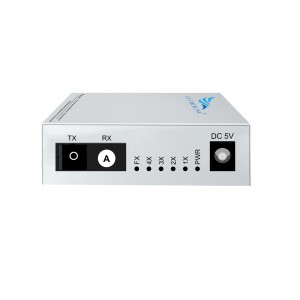
Product application diagra:

How to choose a fiber optic transceiver?
Optical fiber transceivers break the 100-meter limitation of Ethernet cables in data transmission. Relying on high-performance switching chips and large-capacity caches, while truly achieving non-blocking transmission and switching performance, they also provide balanced traffic, isolation and conflict. Error detection and other functions ensure high security and stability during data transmission. Therefore, fiber optic transceiver products will still be an indispensable part of actual network construction for a long time. So, how should we choose fiber optic transceivers?
1. Port function test
Mainly test whether each port can work normally in the duplex state of 10Mbps, 100Mbps and half-duplex state. At the same time, it should be tested whether each port can automatically select the highest transmission speed and automatically match the transmission rate of other devices. This test can be included in other tests.
2. Compatibility test
It mainly tests the connection ability between the optical fiber transceiver and other devices compatible with Ethernet and Fast Ethernet (including network card, HUB, Switch, optical network card, and optical switch). The requirement must be able to support the connection of compatible products.
3. Cable connection characteristics
Test the fiber optic transceiver’s ability to support network cables. First, test the connection ability of Category 5 network cables with lengths of 100m and 10m, and test the connection ability of long Category 5 network cables (120m) of different brands. During the test, the optical port of the transceiver is required to have a connection capability of 10Mbps and a rate of 100Mbps, and the highest must be able to connect to a full-duplex 100Mbps without transmission errors. Category 3 twisted pair cables may not be tested. Subtests can be included in other tests.
4. Transmission characteristics (transmission loss rate of data packets of different lengths, transmission speed)
It mainly tests the packet loss rate when the optical fiber transceiver optical port transmits different data packets, and the connection speed under different connection rates. For the packet loss rate, you can use the test software provided by the network card to test the packet loss rate when the packet size is 64, 512, 1518, 128 (optional) and 1000 (optional) bytes under different connection rates. , the number of packet errors, the number of packets sent and received must be more than 2,000,000. Test transmission speed can use perform3, ping and other software.
5. The compatibility of the whole machine to the transmission network protocol
It mainly tests the compatibility of fiber optic transceivers to network protocols, which can be tested in Novell, Windows and other environments. The following low-level network protocols such as TCP/IP, IPX, NETBIOS, DHCP, etc. must be tested, and the protocols that need to be broadcast must be tested. Optical transceivers are required to support these protocols (VLAN, QOS, COS, etc.).
6. Indicator status test
Test whether the status of the indicator light is consistent with the description of the panel and the user manual, and whether it is consistent with the current status of the fiber optic transceiver.








